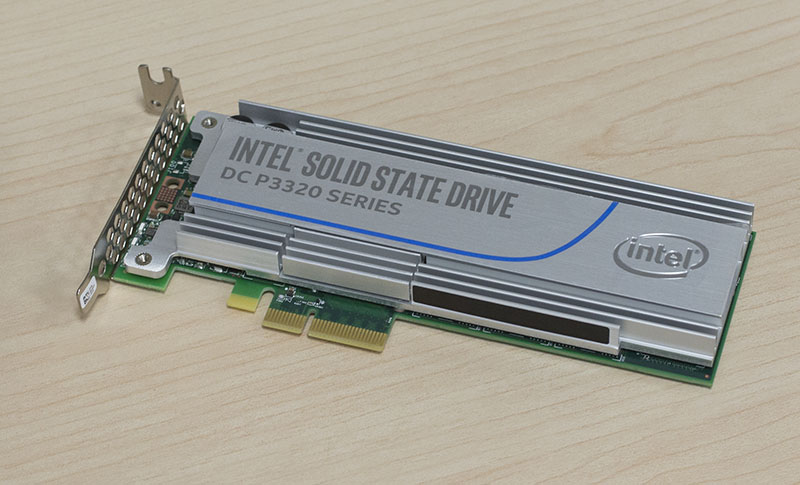At Intel Cloud Day 2016 in San Francisco, California, we saw the release of two new low cost NVMe SSDs, the Intel DC P3520 and DC P3320 series. Both are a major step forward for Intel as they utilize the company’s 3D NAND technology. These are the first SSDs we have seen from Intel with 3D NAND and are expected to lower the cost of entry into enterprise NVMe SSDs. Price wise, we were told the Intel DC P3320 SSD specifically was going to be priced very competitively with SATA drives to start pushing the transition to NVMe.
Positioning the Intel DC P3320 and DC P3520
In the SSD world, manufacturers segment products based on speed, capacity, write endurance. Intel is starting their 3D NAND push with the lower end of the market. We have a companion piece on the Intel DC D3700 and DC D3600 launch if you would like to read about those new SSDs as well. For the Intel DC P3520 and DC P3320, Intel is positioning them below the three main NVMe SSD lines the company has had to date, the DC P3500, DC P3600 and DC P37000 SSD lines. What this practically means is that we will expect lower pricing than previous enterprise NVMe offerings from Intel.

Between the two drives, Intel is positioning the DC P3320 as the low cost entry-level drive while the DC P3520 is one step above. At the formal press briefing in Hillsboro, Oregon Intel only had mentioned the DC P3320. We started receiving word from other parts of Intel and some of the OEMs that the DC P3520 was coming. Less than a week before launch Intel formally updated press briefing materials with the DC P3520.

As one can see with the comparison, the Intel DC P3320 is going to be the “gateway” device optimized for cost. The goal of the drive is to make it an obvious choice over a SATA SSD. The Intel DC P3520 is going to be the higher performing of the two.
On Intel 3D NAND technology
Intel briefed the handful of press flown in for the event on their 3D NAND technology. Intel claims their process, although coming to market later, is a better way to manufacture 3D NAND than its competition (e.g. Samsung 3D VNAND.) Personally, I think it is a bit early to tell and it also sounded a bit like arguing who’s religion is better. Time will tell in terms of who has the better method in terms of pricing and reliability. Samsung has had some issues with its TLC 3D NAND and data retention while Intel is focused on reliability.

Here are the benefits Intel espouses now that it has 3D NAND:

Expected Performance
We are working to get several samples in the STH lab of these drives. For how, here is the official Intel performance claims.

One major point here that the company is emphasizing, Intel is putting a stake in the ground and saying even its lower cost 3D NAND drives will see 90% IOPS consistency, <= 5% performance degradation over the product life and an AFR of <= 0.44%. If you want to know why we run a LOT of Intel SSDs in production, those are the figures to look at.
From what we have heard, the Intel DC P3320 will be priced competitively against the Intel DC S3510, the company’s lowest cost SATA SSD. Pushing this transition to NVMe, Intel is touting a wide range of performance benefits over the DC S3510.

Final Words – What does this mean?
We have been saying that 2016 is going to be the year of the NVMe SSD. By 2017 legacy SATA SSDs are are going to be a low cost/ lower performance play. 15K RPM hard drives will be on their way to extinction.

By the end of 2016, we are going to see 3D TLC NAND and PCIe/ NVMe SSDs hit 10TB capacities from multiple vendors. 3.5″ disks will be the low cost per GB alternative but 3D NAND along with new SSD controllers are going to push us towards SSDs being the high density solutions in addition to the high performance solutions. For those wondering, the question was asked whether Intel’s current generation controllers found on the DC P3320, DC P3520 and the rest of Intel’s NVMe range support 10TB capacities currently. Intel said no so we would expect a new controller at some point to address higher capacity points.
Check out our Intel Xeon E5-2600 V4 coverage, and also our Intel DC P3700 and D3600 dual port NVMe introduction.





I know Intel’s probably quoting long term sustained iops, but those 4k write numbers are a major decrease in performance against the P3600/P3700 series, makes me wonder if those are 3D TLC NAND for the P3320 series?
Now where is the Intel 3D XPoint stuff? Or maybe HPE could me a NVDIMM on NVMmake e interface?